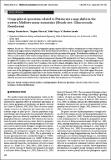Por favor, use este identificador para citar o enlazar a este item:
http://hdl.handle.net/10261/35953COMPARTIR / EXPORTAR:
 SHARE
BASE SHARE
BASE
|
|
| Visualizar otros formatos: MARC | Dublin Core | RDF | ORE | MODS | METS | DIDL | DATACITE | |

| Título: | Geographical speciation related to Pleistocene range shifts in the western Mediterranean mountains (Reseda sect. Glaucoreseda, Resedaceae) |
Otros títulos: | Pleistocene speciation in Reseda sect. Glaucoreseda | Autor: | Martín-Bravo, Santiago; Valcárcel, Virginia; Vargas, Pablo; Luceño, Modesto CSIC ORCID | Palabras clave: | Lineage sorting Mountain endemics Phylogeography Pleistocene glaciations Reseda section Glaucoreseda Vicariance Western Mediterranean |
Fecha de publicación: | abr-2010 | Editor: | Botanischer Garten und Botanisches Museum (Berlin, Germany) | Citación: | TAXON 59 (2): 466–482 (2010) | Resumen: | Reseda sect. Glaucoreseda is a monophyletic group composed of five endemic tetraploid species with a disjunct distribution in the high mountains and plateaus of the Iberian Peninsula and Morocco. It was previously suggested that range shifts induced by Quaternary glaciations played an important role in the speciation of the group. We studied the evolution of R. sect. Glaucoreseda in order to infer historical range dynamics and speciation processes, and to understand current distributional patterns. Phylogeographic analyses were performed using nuclear ribosomal ITS and plastid trnL-F and rps16 sequences. Cloning of additive ITS sequences was carried out to elucidate the origin of intra-individual polymorphisms. A dated phylogeny based on ITS and cpDNA (rbcL, matK, trnL-F) sequences was used to estimate divergence times of R. sect. Glaucoreseda. Time estimates using Penalized Likelihood analyses indicate a late Pleistocene diversification of R. sect. Glaucoreseda. Incomplete lineage sorting of ancestral polymorphisms due to recent divergence, rather than rampant hybridisation, is suggested as the main cause of the phylogenetic incongruence detected between nuclear and plastid datasets. Our results support the vicariance hypothesis for population disjunctions in the Iberian Peninsula, in which an ancestral, widespread species could have undergone differentiation by Quaternary interglacial fragmentation. In contrast, long-distance dispersal across the Strait of Gibraltar may have been involved in the colonisation of North African plateaus by R. battandieri. | Descripción: | 16 páginas, 2 tablas, 3 figuras | Versión del editor: | http://www.ingentaconnect.com/content/iapt/tax/2010/00000059/00000002/art00012 | URI: | http://hdl.handle.net/10261/35953 | ISSN: | 0040-0262 |
| Aparece en las colecciones: | (RJB) Artículos |
Ficheros en este ítem:
| Fichero | Descripción | Tamaño | Formato | |
|---|---|---|---|---|
| Martin-Bravo&al-2009Reseda-GlaucoresedaTaxon.pdf | 2,16 MB | Adobe PDF |  Visualizar/Abrir |
CORE Recommender
Page view(s)
273
checked on 19-abr-2024
Download(s)
406
checked on 19-abr-2024
Google ScholarTM
Check
NOTA: Los ítems de Digital.CSIC están protegidos por copyright, con todos los derechos reservados, a menos que se indique lo contrario.
